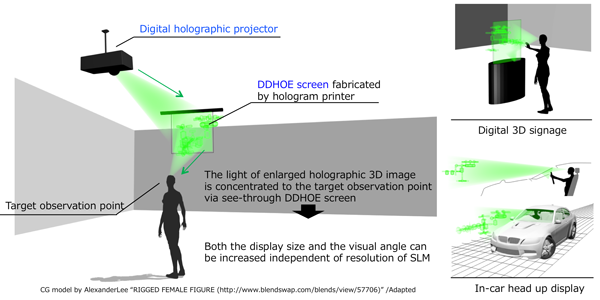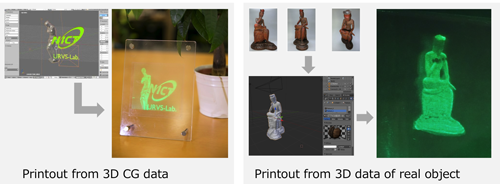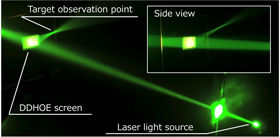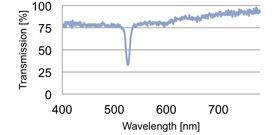Researchers develop projection-type holographic 3-D display technology

NICT has developed a new projection-type see-through holographic 3-D display technology combining an optical screen of a digitally designed holographic optical element (DDHOE) and a digital holographic projection technique. Holographic 3-D image reconstruction was successfully demonstrated via the see-through screen to a target observation area [see Fig. 1].
Basically, dynamic holographic 3-D display technology faces the severe limitation of the spatial-temporal resolution of the spatial light modulator (SLM) to realize a practical display size and visual angle. Moreover, the general system design of holographic 3-D displays requires a large optical setup behind the display window.
In this work, a holographic 3-D image was largely projected to a see-through screen of DDHOE by using the digital holographic projection technique. The screen was fabricated using a hologram printer, which was developed by NICT. The light of the enlarged holographic 3-D image was then concentrated to a target observation area by an appropriately designed reflection function to increase the visual angle. The technology offers a high degree of freedom of both the display size and the visual angle independently, and also the high usability of the see-through display system. It should therefore accelerate the adoption of holographic three-dimensional displays in industrial applications such as digital signage, in-car head-up displays, smart-glasses and head-mounted displays.

The demand for a dynamic 3-D display technology is increasing with the advancement of 3-D printing/scanning technologies. At NICT, several dynamic holographic 3-D displays have been developed. However, general holographic 3-D displays suffer a trade-off between the display size and the visual angle to view the entire display area owing to the severe limitation of the spatial-temporal resolution of current SLMs.
The new display technology allows researchers to flexibly design both the display size and the visual angle independently of see-through holographic 3-D image reconstruction.
For the purpose of creating the new optical technology, the Electromagnetic Application (EMA) laboratory in NICT started the holographic printing technology ("HOPTECH") project in 2014. As a part of this project, a hologram printer for recording a digitally designed wavefront was developed. This printer can not only print 3-D data for visualization [see Fig. 3], but also fabricate a holographic optical element (HOE) with an arbitral reflection function (we call this kind of hologram a digitally designed holographic optical element (DDHOE)).

A new approach was achieved using two key technologies: digital holographic projection to enlarge the display size and fabrication of an optical screen of DDHOE that reflects the light of a projected holographic 3-D image to a target observation area to increase the visual angle [see Fig. 2]. A digital holographic projector was developed by modifying NICT's previous holographic 3-D display system with a projection lens. The appropriate reflection function to concentrate the light of a projected holographic 3-D image to the target observation area was calculated as wavefront information (amplitude and phase distribution of the light) considering the projection parameters. The wavefront of that reflection function was then implemented into a holographic recording film with a hologram printer. In comparison with conventional approaches that use a concave mirror or a convex lens to increase the visual angle of a holographic 3-D image, the new approach can achieve a higher degree of freedom of display size and visual angle. These parameters are important for practical display use by using only a thin film of DDHOE [see Fig. 4]. Additionally, this film has high transparent characteristics at visible light wavelength [see Fig. 5]; this work has applications such as in-car head-up displays, smart glasses, head-mounted displays and digital signage [see Fig. 2].
-

Fig. 4 Optical characteristic of DDHOE screen. Credit: National Institute of Information and Communications Technology -

Fig. 5 Transmission curve of DDHOE screen. Credit: National Institute of Information and Communications Technology
More information: Koki Wakunami et al. Projection-type see-through holographic three-dimensional display, Nature Communications (2016). DOI: 10.1038/ncomms12954 Hisayuki Sasaki et al.
Large size three-dimensional video by electronic holography using multiple spatial light modulators, Scientific Reports (2014). DOI: 10.1038/srep06177
Wide viewing-zone-angle full-color electronic holography system using very high resolution liquid crystal display panels Proc. SPIE 7957, Practical Holography XXV: Materials and Applications, 795709 (February 07, 2011); DOI: 10.1117/12.876763
Journal information: Scientific Reports , Nature Communications
Provided by National Institute of Information and Communications Technology





















